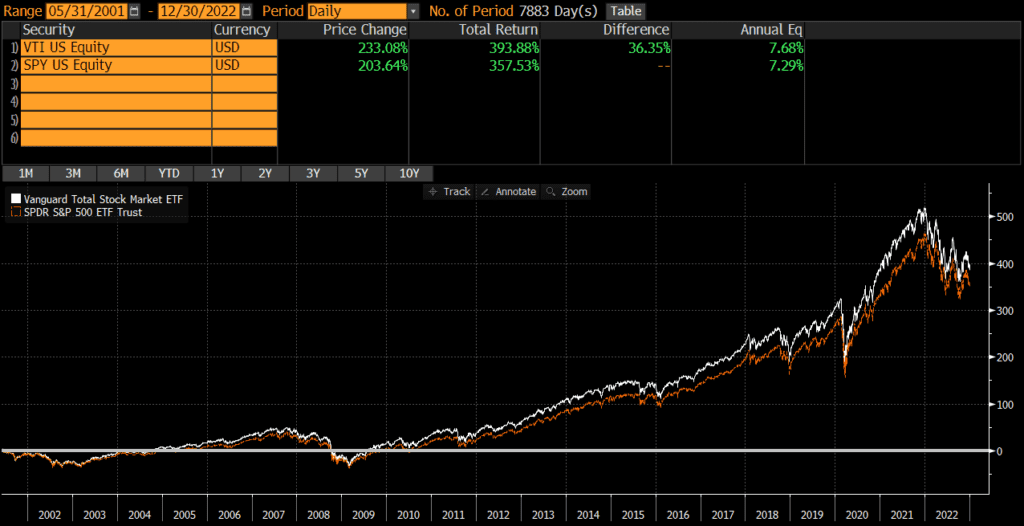The SPDR S&P 500 ETF Trust (SPY) and the Vanguard Total Stock Market ETF (VTI) are two of the largest ETFs and are sponsored by State Street and Vanguard respectively. SPY and VTI are a core holding of many investor portfolios and many investors compare SPY vs VTI in order to decide which should be the foundation of their portfolio.
The Short Answer
The biggest difference is that SPY hold mostly large-cap stocks, while VTI is a “total market fund” and includes more mid-caps and small-caps. Despite these differences, the risk and return between these two funds is nearly identical and I consider them interchangeable.
A quick reminder that this site does NOT provide investment recommendations. Fund comparisons (such as this one) are not conducted to identify the “best” fund (since that will vary from investor to investor based on investor-specific factors). Rather, these fund comparison posts are designed to identify and distinguish between the fund details that matter versus the ones that don’t.
The Long Answer
Historical Performance: VTI vs SPY
SPY was the first ETF ever and was launched back in 1993, while VTI was launched a few years later in May 2000. Since then, VTI has outperformed by .39% annually. That being said, the performance between these two funds is extremely close and shows that modest differences in market cap exposure does not impact total returns that much. The cumulative performance differential over the past two decades is about 36%.

Differences between VTI vs SPY
The biggest difference between SPY and VTI is the market cap exposure of the funds. SPY tracks the S&P 500 index which includes mostly large-caps and some mid-caps. VTI tracks the CRSP US Total Market Index which covers much more of the market by including more mid-caps and small-caps.
Geographic Exposure
Both SPY and VTI hold essentially 100% US stocks, so I will not dig into country exposures or market classification here. For all intents and purposes, the two funds have identical exposures.
Market Cap Exposure
SPY tracks the S&P 500 index and so it mostly holds large-caps with a bit of mid-cap exposure. VTI tracks the broader CRSP US Total Market Index and so it owns many more mid-caps and small-caps. In other words, SPY is a large-cap vehicle and VTI is a total market vehicle. That being said, due to market cap weighting, both funds are overwhelmingly influenced by the large-cap holdings.
| SPY | VTI | |
| Large-Cap | 84% | 73% |
| Mid-Cap | 16% | 19% |
| Small-Cap | 0% | 8% |
Sector Weights
The sector weights between SPY and VTI are nearly identical.
| SPY | VTI | |
| Basic Materials | 2.51% | 2.65% |
| Consumer Cyclical | 9.64% | 9.77% |
| Financial Services | 14.20% | 13.93% |
| Real Estate | 2.81% | 3.51% |
| Communication Services | 7.44% | 6.71% |
| Energy | 5.16% | 5.15% |
| Industrials | 9.11% | 10.07% |
| Technology | 22.62% | 22.48% |
| Consumer Defensive | 7.65% | 6.98% |
| Healthcare | 15.71% | 15.69% |
| Utilities | 3.15% | 3.07% |
Expenses
The expense ratio for VTI funds is .03%, while SPY’s is .0945%. On the one hand, SPY is 3x more expensive than VTI. One the other hand, its only a 6.5 basis point difference and not material in my opinion. Investors looking for a lower cost S&P 500 ETF may want to consider IVV or VOO. Read my comparison of VOO vs VTI or VTI vs IVV.
Transaction Costs
ETFs are free to trade at many brokers and custodians, so both SPY and VTI should be free to trade in most cases. Additionally, these funds are among the largest ETFs and are very liquid. The bid-ask spread of both SPY and VTI is about .01%, so individual investor trades will not generally be large enough to “move” the market.
Tax Efficiency & Capital Gain Distributions
ETFs are typically more tax-efficient than mutual funds, due to their ability to avoid realizing capital gains through like-kind redemptions (a process that is beyond the scope of this post). VTI has never made a capital gains distribution and SPY has not made a capital gains distribution since 1996 (and I do not expect it to moving forward). Thus, these funds are about as tax-efficient as any fund can be and either fund is appropriate in taxable accounts.
Options Strategies
The one situation where I would recommend SPY rather than VTI is when an investor plans to integrate covered calls or other options strategies since SPY options are WAY more liquid than VTI. Or someone might want to use VTI to avoid triggering wash sales with their SPY options. It is just something to keep in mind.
Final Thoughts: VTI vs SPY
Both SPY and VTI are large, core funds sponsored and managed by two of the largest investment sponsors in the world. Although SPY is more of a large-cap ETF and VTI is a total market ETF, performance has been extremely similar.
I view these two funds as essentially interchangeable and would not spend too much energy splitting hairs to decide which one is “better” (unless one has a clear view on whether larger caps or smaller caps will perform better in the future and even then the difference won’t be much)! In my opinion, both funds are among the best ETFs out there and investors cannot really go wrong with either.